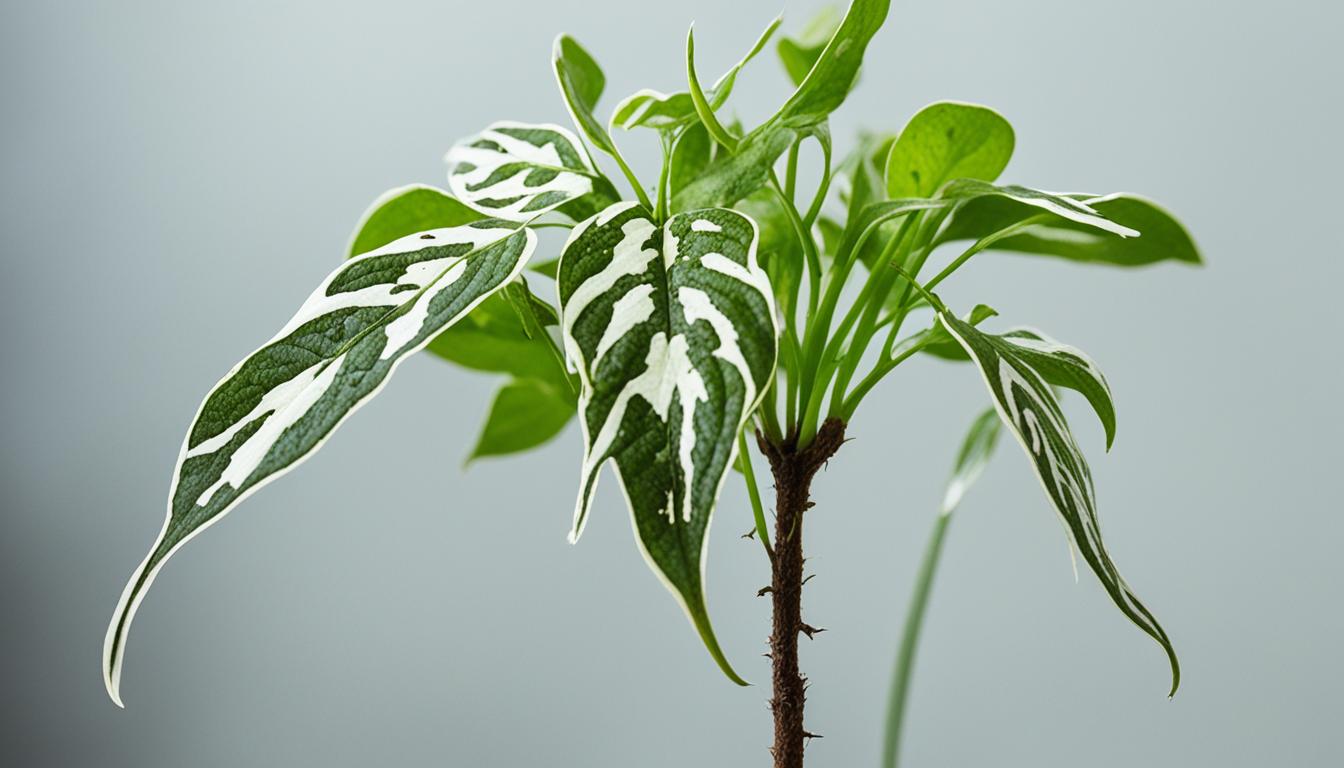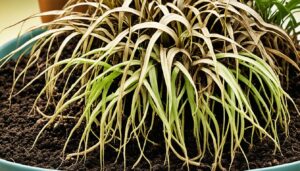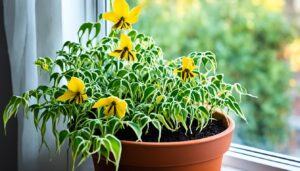Are your once-vibrant houseplants now wilting, discolored, or showing strange growths? A common cause might be a fungal infection. But, you can fight back with the right strategies and treatments. This guide will cover the types of fungi, symptoms, prevention, and treatment options for your houseplants.
Fungal infections can be tough on houseplants, but you can beat them with knowledge and the right steps. Let’s learn how to keep your indoor plants healthy and looking great.
Understanding Fungal Infections in Houseplants
Keeping your indoor garden healthy means knowing about fungi and their effects on houseplants. Some fungi are good, while others can harm your plants. It’s important to understand the difference.
Types of Fungi: The Good, the Bad, and the Ugly
Not all fungi are bad for your plants. Some can even help by breaking down organic matter and improving soil. But, harmful fungi like sooty mold, powdery mildew, and gray mold can cause problems. They can lead to leaf spots, discoloration, wilting, and even death.
Common Symptoms and Signs of Fungal Infections
Knowing the early signs of fungal infections helps you treat and prevent them. Common symptoms of fungal diseases in houseplants include:
- Leaf spots or discoloration
- Wilting or stunted growth
- Powdery or fuzzy growth on leaves and stems
- Root rot or crown rot
- Mushroom or fungal growth on the soil or plant
Learning these fungal disease symptoms lets you act fast. This way, you can stop houseplant fungus problems before they get worse.
Knowing about different fungi and their effects is key to a healthy indoor garden. Always watch for signs of plant disease identification. This helps keep your houseplants healthy and free from diseases.
Preventing Fungal Infections in Houseplants
Keeping your houseplants healthy is key to stopping fungal infections. Focus on fungus prevention, humidity control, and air circulation. This makes your plants less welcoming to harmful fungi.
Environmental Control Strategies
Good air circulation helps keep away fungal spores. Make sure your plants get enough air by using fans or opening windows. Also, keep an eye on the humidity levels indoors. Fungi love damp places.
Proper Watering Techniques
Too much water can lead to fungal infections. Be careful when watering houseplants. Don’t let the soil stay wet for too long. Let it dry out a bit before watering again. Also, pay attention to your soil management. Good drainage helps prevent fungi.
“By understanding and addressing the specific environmental needs of your houseplants, you can create an inhospitable environment for harmful fungi to thrive.”
With these steps, you can lower the chance of fungal infections. Your indoor plants will stay healthy and full of life.
Dealing with Mushrooms: The Harmless Fungi
Seeing mushrooms in houseplants might worry you, but most soil fungi are harmless. Some harmless fungi even help by breaking down organic matter. This makes your indoor plant care better.
Mushrooms love warm, humid places and feed on old plant matter. They help by making the soil airy and releasing nutrients for your plants. If mushrooms aren’t hurting your plants, you can just leave them alone.
If you have pets or kids, it’s smart to remove mushrooms to keep them safe. Some fungi can be bad if eaten. You can easily pick them up with gloves and a trowel and throw them away.
“Mushrooms in the soil are a sign of a healthy, thriving ecosystem – they’re not something to be feared, but rather embraced as part of the natural cycle of plant growth and decomposition.”
Knowing about harmless fungi in your indoor plant care helps you manage mushrooms. This way, your houseplants will keep doing well.
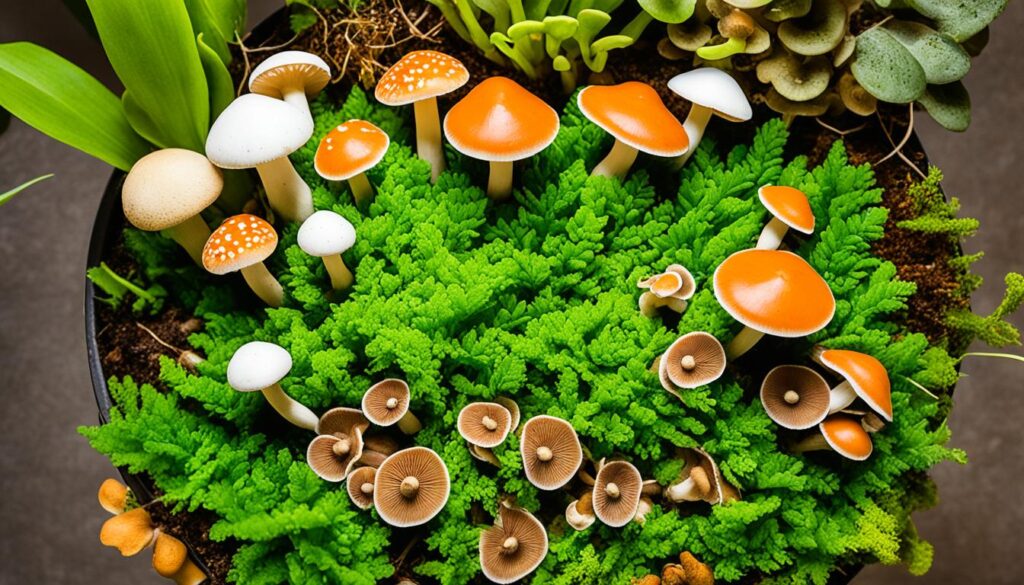
Fighting Fungal Infections in Houseplants
Fungal infections can be a big problem for houseplant lovers. But, with the right steps, you can beat these pests. For serious issues like sooty mold, powdery mildew, white mold, and gray mold (Botrytis), you need a strong plan.
Treating Sooty Mold and Powdery Mildew
Sooty mold and powdery mildew often come from pests. Clean the leaves well and use the right fungal disease treatment to get rid of them.
Controlling White Mold and Gray Mold (Botrytis)
White mold and gray mold need more work. You might need to repot the plant, use fungicides, and watch the environment closely. Fix the root cause and use specific treatments to stop these fungi from coming back.
It’s key to fix the problems that led to the fungal infections. This includes poor air flow, too much water, or high humidity. Keep an eye out and act fast to keep your houseplants healthy and pest-free.
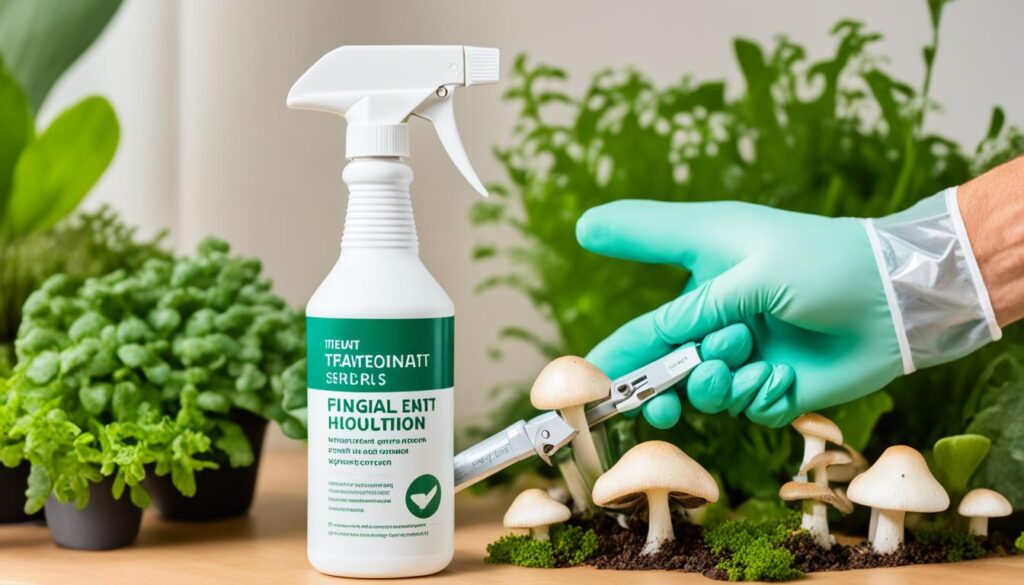
Battling Stem, Crown, and Root Rot
Stem, crown, and root rot are serious fungal infections that can harm your houseplants. They often come from too much water and poor air flow. This lets the fungus spread fast through the plant’s important parts. If not treated, these infections can kill the plant.
To fight this, you need to do several things. First, find and remove any infected parts of the plant. This means taking the plant out of its pot and checking the roots, stems, and crown for rot or color changes. Get rid of any infected parts you find.
Then, change how you water your plants. Too much water can cause stem rot, crown rot, and root rot. Make sure your plants get the right amount of water, letting the soil dry out a bit between waterings. Also, make sure there’s good air flow around your plants to stop the fungus from spreading.
Sometimes, you need to repot your plant in fresh, clean soil. This helps get rid of any remaining infection and gives the plant a fresh start. When repotting, use a potting mix that drains well and think about adding a fungicide to the soil for extra protection.
By watching your plants closely, watering them right, and acting quickly, you can beat stem rot, crown rot, and root rot. Being proactive and dealing with these fungal plant diseases early keeps your plants healthy and happy for a long time.
Fungal Infections in Houseplants: Management Tips
Keeping your houseplants healthy is key to avoiding and handling fungal infections. Using safe and effective antifungal methods, along with good plant care, helps your plants stay green and strong.
Safe and Effective Antifungal Solutions
Chemical fungicides can fight fungal diseases but might not be safe for homes with pets or kids. A better choice is a baking soda spray. It’s a natural fungicide that works against many fungal problems, like sooty mold and powdery mildew.
Using essential oils like tea tree or neem oil is another good option. These natural fungicides can be mixed and sprayed on plants to fight fungal infections gently but effectively.
Maintaining Plant Health and Vigor
It’s not just about using antifungal treatments. Keeping your plants healthy and strong is key to fighting off fungal infections. Good watering techniques, enough air around them, and the right growing conditions boost their defense against fungal diseases.
By following plant care tips and using safe, effective methods, you can keep your houseplants healthy. This way, you can enjoy a beautiful indoor garden without fungal infections.
Conclusion
Fungal infections can be tough on houseplants, but you can fight them with the right steps. Learn about the different fungi, spot the symptoms early, and use a good management plan. This way, your houseplants will stay healthy and safe from fungal diseases.
Throughout this article, we’ve looked at how to handle fungal infections in houseplants. We covered everything from identifying good and bad fungi to tackling issues like sooty mold, powdery mildew, and root rot. By using the tips and solutions we shared, you’ll be on your way to a disease-free indoor garden.
Keeping your houseplants healthy is rewarding. With the right knowledge and care, you can beat fungal infections. Your plants are strong, and with your help, they’ll keep growing. They’ll bring beauty and nature into your home.
FAQ
What are the different types of fungi that can affect houseplants?
Fungi can be good or bad for houseplants. Some are harmless or even helpful, but others can harm a lot. They can cause spots, discoloration, wilting, and even death. Common bad ones include sooty mold, powdery mildew, and gray mold.
What are the common symptoms of fungal infections in houseplants?
Knowing the signs of fungal infections helps in treating and stopping them. Look for leaf spots, discoloration, wilting, and plant death.
How can I prevent fungal infections in my houseplants?
To stop fungal infections, make your plants’ environment less welcoming for fungi. Ensure good air flow, the right humidity, and correct watering.
What should I do if I find mushrooms in my houseplant’s soil?
Not all fungi in your plant’s soil are bad. Mushrooms are harmless fungi that can grow in warm, humid places. They break down soil and are safe for your plants. If you’re okay with them, leave them. But remove them if you have pets or kids.
How can I treat more serious fungal infections in my houseplants?
For serious fungal infections like sooty mold, powdery mildew, white mold, and gray mold, you need to act fast. Treat pests, clean leaves, repot, use fungicides, and watch the environment to stop more problems.
What is stem, crown, and root rot, and how can I address it?
Stem, crown, and root rot is a big problem for houseplants. It comes from too much water and bad air flow, letting fungi spread. To fix it, cut out infected parts, change your watering, and might need to repot in fresh soil.
What are some safe and effective solutions for treating fungal infections in houseplants?
Chemical fungicides might work but aren’t always safe, especially with pets or kids. A safer choice is a baking soda spray, which fights fungi well. Keeping your plants healthy also helps prevent fungal problems. Good watering, air flow, and growing conditions boost your plants’ defense against fungi.


